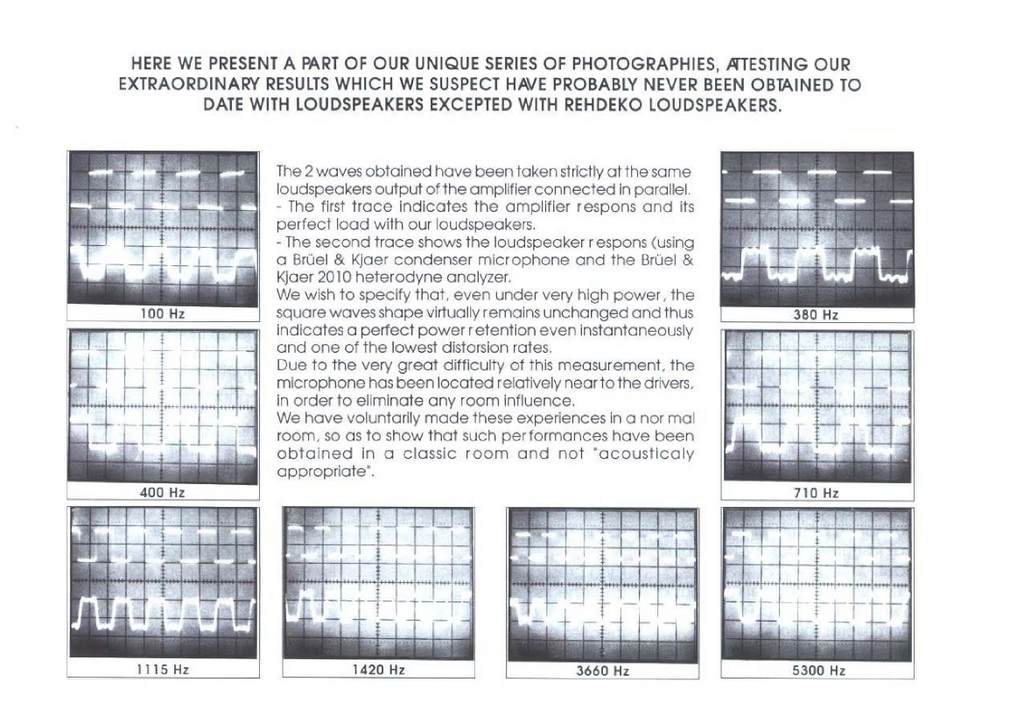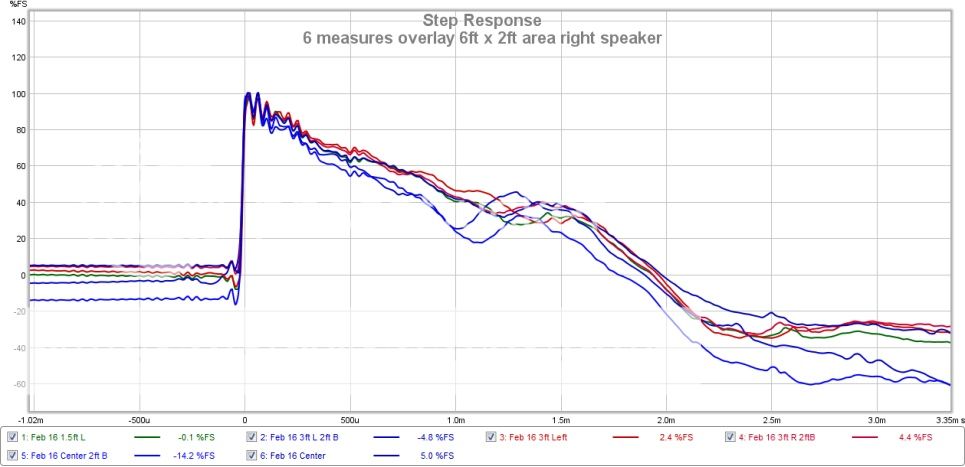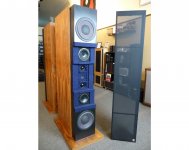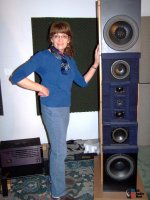Hi,
looking for information about speakers testing i have found this table showing an excellent response of the speaker to square wave.

I wonder if this kind of test can tell something about the sound quality of a speaker.
Thanks and regards,
gino
looking for information about speakers testing i have found this table showing an excellent response of the speaker to square wave.

I wonder if this kind of test can tell something about the sound quality of a speaker.
Thanks and regards,
gino
Member
Joined 2009
Only speakers with a Linear Phase can reproduce a square wave.
Conventional IIR crossovers introduce a phase shift that alters the waveform. This distortion is generally considered inaudible. Exotic FIR crossovers, 1st order IIR crossovers and single driver speakers are the common approaches to building a linear phase speaker.
Conventional IIR crossovers introduce a phase shift that alters the waveform. This distortion is generally considered inaudible. Exotic FIR crossovers, 1st order IIR crossovers and single driver speakers are the common approaches to building a linear phase speaker.
there are higher order linear phase, linear (analog, RLC) filter alignments possible although they "waste" some driver frequency and SPL range by having larger overlap regions
but XO and driver filter response summing flat, linear phase is not a guarantee of good radiated soundfield response given the physical separation and size/directivity differences of multiple drivers - may only happen along a specifically angled axis between the multiple drivers and be increasingly poor away from that axis
there is research - not just anecdote - that midband phase rotation from allpass filters given the same phase/frequency found in some popular high order XO multiway loudspeakers can be heard with test signals, and some music, the ability may need training to develop the sensitivity - most easily controlled, tested with simulated phase shifts while listening with good quality headphones
however the effect of "non linear" phase (frequency variable group delay) in common loudspeaker design doesn't seem to be a major audible defect as long as both channels match
but XO and driver filter response summing flat, linear phase is not a guarantee of good radiated soundfield response given the physical separation and size/directivity differences of multiple drivers - may only happen along a specifically angled axis between the multiple drivers and be increasingly poor away from that axis
there is research - not just anecdote - that midband phase rotation from allpass filters given the same phase/frequency found in some popular high order XO multiway loudspeakers can be heard with test signals, and some music, the ability may need training to develop the sensitivity - most easily controlled, tested with simulated phase shifts while listening with good quality headphones
however the effect of "non linear" phase (frequency variable group delay) in common loudspeaker design doesn't seem to be a major audible defect as long as both channels match
Last edited:
Careful choice of frequencies and microphone positioning will occasionally yield
some good looking square waves with loudspeakers which do not generally have
a such excellent square wave response.
😎
some good looking square waves with loudspeakers which do not generally have
a such excellent square wave response.
😎
NP is hinting at the fact the the response will change with position relative to the loudspeaker. This is because in order for the speaker to reproduce a square wave all the different frequency components must arrive at the same time (in phase). But as you move esp. in the vertical plane, the distances to each driver change, and so does the phase. You can sometimes find points in space for which things align nicely but move a foot away and the square wave may no longer be constructed properly.
Even FIR filters that make the phase linear suffer from this phenomenon - that is they really only have this property at one point in space.
Even FIR filters that make the phase linear suffer from this phenomenon - that is they really only have this property at one point in space.
Thank you all for the very kind and valuable advice
If i understand rightly what is depicted as a great achievement has no practical consequences on the actual quality of the speaker sound
Now i also understand why this test is so uncommon.
Thanks a lot and kind regards,
gino
If i understand rightly what is depicted as a great achievement has no practical consequences on the actual quality of the speaker sound
Now i also understand why this test is so uncommon.
Thanks a lot and kind regards,
gino
Nope not entirely , like anything else involving measurements in audio, the real story is not told by just one form of measurement.
Hi,
looking for information about speakers testing i have found this table showing an excellent response of the speaker to square wave.
I wonder if this kind of test can tell something about the sound quality of a speaker.
Thanks and regards,
gino
Wrt speaker system testing in the time domain, typically the step response of the speaker is what is measured:
Measuring Loudspeakers, Part Two Page 2 | Stereophile.com
Measuring Loudspeakers, Part Two Page 3 | Stereophile.com
The links above show examples of what a "good" step response looks like.
One can use REW, a free measurement tool, to measure and inspect the step response of a speaker system, along with many other measures.
While some may disagree, personally from REW measurements, I have found the "quality" of sound increases from a speaker system that is time coherent as compared to speakers that are not. My experiment involved ripping out a passive 3 way XO, replaced with 3 way digital XO and time aligning the drivers, while measuring the before and after step responses.
As the Stereophile article notes, there are really few speaker systems that measure time coherent, so unless one has listened to a speaker system that measures time coherent, it is hard to compare.
One measure I did want to include is to show that the step response remains relatively the same at 6 different mic locations across a 6' x 2' measurement grid (i.e. couch listening area) of my right speaker some 9ft away:

All the fancy DSP in Sound Easy UE may make a square wave look better, but I am not at all convinced it matters any to the actual sound.
All the fancy DSP in Sound Easy UE may make a square wave look better, but I am not at all convinced it matters any to the actual sound.
For the most part, I agree, but there may be some potential, if a time aligned wavefront actually makes it to the listening location, for a more highly detailed, better integrated listening experience.
All the fancy DSP in Sound Easy UE may make a square wave look better, but I am not at all convinced it matters any to the actual sound.
It makes a difference but it cannot be the only criteria to test and judge a speaker system by ....
Wrt speaker system testing in the time domain, typically the step response of the speaker is what is measured: ...
Thank you very much indeed for the very valuable explanations
In very basic terms i would expect that a speaker outputs a wave very similar to the input (i know this is quite trivial but then it should be like this)
And this seems not so easy to achieve
If a single driver can give a good square wave as output then the murderer is the crossover.
If a crossover cannot pass a quite good square wave this is bad i think
I understand that while active XOs have no problems to achieve this, only 1st order passive XOs can do the same.
If this is true i think it is important
Thanks again and kind regards,
gino
It should be noted that Rehdeko speakers use series XOs -- their info shown in post 1.
dave
Hi and thanks for the info !
Series XOs ? what are they ? which order are they ?
Regards, gino
I understand that while active XOs have no problems to achieve this, only 1st order passive XOs can do the same.
It is indeed possible to achieve this with active crossovers but don't assume all active crossovers can achieve it.
For me the shown measurements look much too nicely to be believable, specially the one at 100 Hz.
Regards
Charles
Series vs. Parallel Crossover Networks
The square wave response in post 1 suggests that the uses 1st order XOs.
I have had good success with series XOs in FASTs where the XO is 200-400 Hz.
dave
The square wave response in post 1 suggests that the uses 1st order XOs.
I have had good success with series XOs in FASTs where the XO is 200-400 Hz.
dave
Series vs. Parallel Crossover Networks
The square wave response in post 1 suggests that the uses 1st order XOs.
I have had good success with series XOs in FASTs where the XO is 200-400 Hz.
dave
Hi and thanks again for the kind and valuable reply
I should have said that i have big difficulties to understand all the science (read math) behind phenomena.
Let me say that i prefer accurate speakers, even if this means less "musicality".
So my question can be rephrased as follows: can a speaker not able to pass decently a square wave called accurate ? i do not think so.
It could be due to the driver, to the xover or both i agree.
But still it will not be accurate.
Instead if we talk about "musicality" everything is possible.
The concept of musicality is very subjective.
Moreover i think that more or less electronics have no problem with square waves
So it is mostly a speakers issue.
Thanks and regards
gino
P.S. i do not know if they have cheated with pictures of course.
But still they propose this test as a valuable one.
Last edited:
Square waves contain far more frequency components than audio signals.
Trying to reproduce square waves with loudspeakers is unnecessary and impossible.
Transducers, microphones and loudspeakers, are bandwidth limited both in low and high frequencies.
Order 1 crossovers give nice square response when the summation of the low pass and high pass channels is done in the electrical domain. When drivers enter the game, the acoustical response is somewhat less ideal.
However, your concern may be only addressed to crossovers.
Trying to get decent transient responses from loudpseakers is still an aim. With this idea in mind, some work has been made since 2000 under the Jean-Michel Le Cleac'h's impulsion to reduce the group delay variations introduced by crossovers (search "quasi optimal"). For instance :
http://www.diyaudio.com/forums/mult...sover-high-efficiency-loudspeaker-system.html
Trying to reproduce square waves with loudspeakers is unnecessary and impossible.
Transducers, microphones and loudspeakers, are bandwidth limited both in low and high frequencies.
Order 1 crossovers give nice square response when the summation of the low pass and high pass channels is done in the electrical domain. When drivers enter the game, the acoustical response is somewhat less ideal.
However, your concern may be only addressed to crossovers.
Trying to get decent transient responses from loudpseakers is still an aim. With this idea in mind, some work has been made since 2000 under the Jean-Michel Le Cleac'h's impulsion to reduce the group delay variations introduced by crossovers (search "quasi optimal"). For instance :
http://www.diyaudio.com/forums/mult...sover-high-efficiency-loudspeaker-system.html
... can a speaker not able to pass decently a square wave called accurate ?
Most loudspeakers cannot reproduce a reasonable facsimile of a square wave -- it takes very good phase response & very extended HF extension.
Accurate is also a very hard term to nail down.
dave


Duntech loudspeakers were noted for their time aligned construction (and simple order crossovers).
The Sovereigns give stunningly good depth reproduction, when fed correct absolute polarity.
Crossover phase rotations and lousy driver time alignment adds up to sonic confusion.
It is worth getting time alignment correct, actively or passively (physical construction).
Dan.
- Status
- Not open for further replies.
- Home
- Member Areas
- The Lounge
- Square wave test on speakers - what does it tell ?